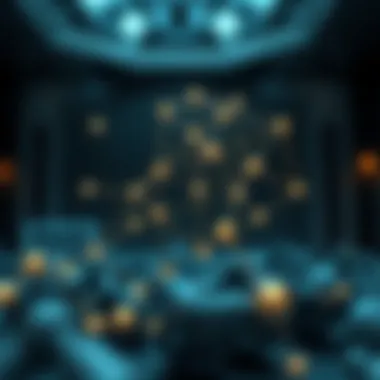Exploring the Role of DAG in Cryptocurrency


Intro
In the rapidly evolving world of digital finance, understanding the technology behind cryptocurrency is crucial. Among the various architectures that support cryptocurrencies, Directed Acyclic Graphs (DAGs) are gaining traction due to their unique properties. Unlike traditional blockchain, which relies on a linear structure, DAG allows for multiple paths or connections, enhancing scalability and efficiency. This exploration is not just a technical deconstruction but also a broader examination of how DAG impacts the realm of digital currencies.
This article aims to unpack the essentials of DAG technology, reflecting on its significance and potential to redefine how we perceive and interact with cryptocurrencies. Understanding its fundamentals can empower investors, tech enthusiasts, and developers alike to make informed decisions in this intricate landscape.
Understanding Cryptocurrency Frameworks
In the world of digital currencies, comprehending the frameworks that underpin them is crucial. Understanding Cryptocurrency Frameworks lays the foundation for grasping both the potential and pitfalls of these technologies. By dissecting what makes up these frameworks, including key components such as consensus algorithms, transaction mechanisms, and data structures, readers can appreciate the initial steps toward navigating the crypto space.
The Evolution of Digital Money
The idea of digital money has undergone significant transformations since its inception. Initially, digital currencies emerged as mere extensions of traditional fiat money, with early forms like e-gold being essentially digital representations of value. As we moved into the 21st century, peer-to-peer payment systems like PayPal started gaining traction, paving the way for more sophisticated models.
Bitcoin, launched in 2009 by the pseudonymous Satoshi Nakamoto, revolutionized digital money by introducing a decentralized approach governed by cryptographic principles. This paradigm shift allowed users to transact directly without intermediaries, setting the stage for a flurry of other cryptocurrencies that followed, each bringing its own unique features and advantages. From Ethereum’s smart contracts to Ripple’s focus on speed in cross-border payments, the landscape of digital money continued to evolve.
As digital currencies have grown, so have the understandings of their potential applications and the communities that support them. For example, communities often rally around cryptocurrencies, fostering a sense of belonging among users, developers, and investors. This evolution is crucial to grasping how cryptocurrency frameworks have adapted to meet changing market demands.
Blockchain: The Traditional Model
Blockchain technology emerged as the backbone of today’s cryptocurrency ecosystem. At its core, blockchain is a decentralized ledger that records transactions across many computers. This decentralization ensures that no single entity holds control over the data, enhancing trust between users.
A blockchain is built from blocks of data, each linked to the previous one in a chronological chain. This method provides transparency, as participants can audit the entire history of transactions. Moreover, consensus algorithms like Proof of Work or Proof of Stake create a secure structure that enables the network to agree on a single source of truth, a crucial element for any currency.
However, while blockchain has established itself as the conventional model for many cryptocurrencies, the limitations of such a system lie in scalability. As transaction volumes increase, the time and resources required to validate transactions can become burdensome. This has sparked interest in alternative designs, such as Directed Acyclic Graphs (DAGs), which seek to overcome these challenges.
DAG: An Alternative Architecture
DAG, or Directed Acyclic Graph, presents itself as a disruptive alternative to the traditional blockchain architecture. Unlike blockchain, where transactions are grouped into blocks, a DAG handles individual transactions. In this model, each transaction confirms previous transactions, creating a web of connectivity that eliminates the need for miners.
One major advantage of DAG is its scalability. Because transactions can occur simultaneously and are not held back by block sizes or waiting for confirmation of blocks, the throughput can increase as the network grows. This structure has garnered attention for applications in high-volume payment systems, where speed and efficiency are essential.
For instance, IOTA employs this architecture, focusing on the Internet of Things (IoT), drawing connections between devices with minimal overhead.
The Mechanics of Directed Acyclic Graphs
Understanding the mechanics of Directed Acyclic Graphs, commonly referred to as DAGs, reveals the intricacies of a system that stands apart from conventional blockchain architectures. In this part, we delve into the foundational elements of DAGs, exploring how they operate and what sets them apart in the cryptocurrency sector. These insights are crucial for both seasoned investors and tech enthusiasts who seek to comprehend the underlying technology of modern digital currencies.
Defining DAGs in Computing
At its core, a Directed Acyclic Graph is a data structure that moves in one direction, allowing each node to point only to subsequent nodes, meaning no cycles can form. This characteristic offers a unique way of organizing and storing information. Unlike traditional blockchains, where each block contains transaction data that references a previous block, DAGs allow for multiple paths of transaction validation. This flexibility not only enhances efficiency but also minimizes latency, making it suitable for high-transaction environments.
For example, in a DAG network, users can validate transactions simultaneously rather than waiting for a single block to be mined. This can drastically reduce transaction times, which is crucial in the fast-paced world of cryptocurrencies.


Core Principles of DAG Functionality
Several core principles underlie the functionality of DAGs, each contributing to the system's efficiency and usability:
- Decentralization: Transactions occur without a central authority, allowing every participant in the network to play a role in transaction verification. This reduces the risk of central points of failure.
- Parallel Validation: Multiple transactions can be verified at the same time, as each user can confirm earlier transactions that they reference. This is a stark contrast to the linear validation required in traditional blockchains.
- Lightweight Structure: Because DAGs do not bundle transactions into blocks, they consume less network space and require fewer computational resources. This leads to lower energy consumption and, in turn, lowers operating costs for miners and users alike.
These principles contribute to the growing interest in DAG technology for applications beyond cryptocurrencies.
Comparison with Traditional Blockchain Structures
The differences between DAGs and traditional blockchain systems are marked and merit close examination. Here are several key comparisons:
- Transaction Speed: In conventional blockchains, the transaction speed is often hampered by the block confirmation time, the waiting period for miners to validate a new block. In a DAG, transactions can be confirmed almost instantaneously because multiple confirmations occur simultaneously.
- Scalability: Traditional blockchains face critical scalability issues as they grow. The more users, the more congested the network becomes, leading to slower speeds and higher fees. DAGs naturally scale to accommodate increased transactions, as they rely on a network of nodes rather than a linear block structure.
- Security: While blockchain technology employs cryptographic hashes to secure each block, DAGs use a different approach, relying more on the users in the network to validate transactions. However, this raises questions about the integrity of verification and potential vulnerabilities that could be exploited.
"DAGs present a remarkable alternative to traditional systems, overcoming many hurdles. Yet, like any evolving technology, they too carry their own set of concerns that need addressing to foster widespread adoption.”
The conversation surrounding DAGs versus traditional blockchains highlights the exciting possibilities and challenges posed by new tech in the cryptocurrency landscape. As the sector continues to evolve, the mechanics of these systems warrant ongoing scrutiny and analysis.
Applications of DAG in Cryptocurrencies
The landscape of cryptocurrencies is vast and varied, signaling a dynamic transformation in how transactions are processed and recorded. Among these innovations, Directed Acyclic Graphs (DAGs) are carving a niche that is worth a deeper dive. The advent of DAG structures is not merely an academic exercise; they are practical avenues toward enhancing the overall functionality of digital currencies. By accommodating scalability and efficiency, DAG is on the frontline of changes that speak to the very core of how payment systems could evolve. In this section, we will explore several key aspects of DAG, shedding light on how they are shaping the future of cryptocurrency.
DAG in Payment Solutions
One of the most immediate applications of DAG technology lies in payment solutions. Traditional cryptocurrency payment systems can become bogged down in transaction speed and fees, especially during peak activity periods. DAG offers a remedy for these headaches, allowing for faster transactions while effectively reducing costs.
- Fast Transactions: DAG operates on a system where each transaction confirms previous ones, making it possible to process multiple transactions almost simultaneously. This is akin to creating a web of connections where each new action stabilizes the entire setup, ramping up the speed considerably.
- Lower Fees: Unlike traditional blockchain networks that require miners and their associated costs, DAG-based cryptocurrencies often do not require transaction fees. Rather, users validate transactions they create, which not only minimizes costs but also incentivizes participation. For example, IOTA, a well-known DAG project, emphasizes fee-less transactions that can enhance everyday usability.
- MicroPayments: Given the lack of fees associated with DAG systems, they serve as an ideal platform for micropayments, where users can send small amounts of money without incurring prohibitive costs. This opens avenues for new economic models in digital services and P2P transactions.
Smart Contracts and Beyond
DAG technology is not confined to just payment solutions; it extends into the realm of smart contracts as well. With smart contracts being heralded as the next big advancement in blockchain technology, their interaction with DAG architecture presents exciting possibilities.
- Increased Flexibility: DAG can handle smart contracts in a more efficient manner, with fewer computational requirements than traditional blockchain systems. This flexibility paves the way for more complex smart contracts that can interact with a variety of services seamlessly.
- Integrating with Other Crypto Assets: Another interesting aspect is the potential for DAG-based smart contracts to interact with assets belonging to both DAG and traditional blockchain ecosystems. This interoperability is fundamental for creating a synchronized environment where diverse digital currencies and contracts coexist and operate cohesively.
- Real-Time Execution: The overlapping nature of transactions in a DAG structure allows for real-time execution of smart contracts, a significant upgrade from some slower, traditional blockchain systems that can take considerable time for confirmations.
Case Studies of Notable DAG Cryptos
To grasp the practical implications of DAG, examining a few noteworthy cryptocurrencies that utilize this technology is beneficial. These case studies highlight differing approaches and applications of DAG in real-world scenarios.
- IOTA: Arguably one of the most recognized DAG cryptocurrencies, IOTA stands out for its focus on enabling devices in the Internet of Things (IoT) ecosystem. With its zero-fee structure, IOTA has carved out a specific niche that makes it attractive for machine-to-machine transactions, where speed and cost are paramount.
- Nano: Previously known as RaiBlocks, Nano uses a unique block-lattice structure to facilitate rapid transactions. With its focus on nearly instantaneous processing, it is aimed at providing a seamless experience for everyday transactions, positioning itself against traditional payment systems.
- Hedera Hashgraph: Though slightly different in its implementation, Hedera Hashgraph embraces a form of DAG to facilitate a high throughput of transactions while maintaining security and fairness. It is designed to quickly process transactions for decentralized applications without incurring high costs or delays.
"As the cryptocurrency sphere continues to innovate, understanding applications, especially with cutting-edge technologies like DAG, is crucial for investors and developers alike."
The Advantages of DAG Technology
The shift towards Directed Acyclic Graph (DAG) technology in cryptocurrency has sparked significant interest among investors, developers, and tech enthusiasts. Unlike the traditional blockchain model, DAG presents unique advantages that cater to the evolving demands of the digital currency landscape. With an emphasis on speed, cost-effectiveness, and security, these benefits open the door to innovative applications and greater scalability.


Scalability and Speed
One of the primary draws of DAG technology is its inherent scalability. Unlike blockchains, where every transaction must be confirmed in a sequential order, DAGs allow for multiple transactions to be processed simultaneously. This parallel processing capability means that, as the user base grows, the network can accommodate an increasing volume of transactions without a hitch.
For instance, in a DAG-based system, the more users that join the network, the faster the transactions can occur. Picture a busy highway where additional lanes are added as traffic increases; this ensures that congestion is minimized. A notable example is IOTA, which employs a DAG structure called the Tangle. This system escalates throughput without burdening the network, leading to what can be described as lightning-fast transaction speeds even during peak times.
Lower Transaction Costs
DAG technology tends to come with significantly lower transaction costs compared to traditional blockchain networks. The reason? The absence of miners. In many blockchain systems, miners are required to validate and confirm each transaction, which incurs fees that can escalate during periods of high network activity. In contrast, DAG systems usually utilize a different approach: users confirm their own transactions, which diminishes the need for excessive intermediary costs.
This characteristic not only lowers the barrier to entry but also promotes broader adoption. Users can conduct microtransactions without worrying about proportionate fees cutting into their profits. For example, platforms like Nano illustrate how cost-efficient transactions can empower users to engage in everyday transactions without financial strain, thus creating a more integrated digital economy.
Enhanced Security Measures
Security is paramount in the digital currency space, and DAG addresses this concern in innovative ways. While blockchains rely on consensus mechanisms like Proof of Work or Proof of Stake, DAG employs a different security model. Each node in a DAG must confirm previous transactions, creating a self-validating system that reduces the risk of attacks.
A crucial point here is the resilience of DAGs against certain types of attacks, such as double-spending. Since each transaction is interlinked with others, manipulating or invalidating a single transaction requires altering several confirmations, making it a herculean task.
Moreover, the decentralized nature of DAG networks inherently shields them from single points of failure. As the network expands, so does its security. Each additional node contributes to the overall integrity, making it increasingly difficult for malicious actors to compromise the system. As seen in projects like Hedera Hashgraph, which leverages the benefits of DAG architecture, the results have shown promise in providing a robust and secure transaction environment.
"DAG technologies are not just alternatives; they are paths towards future innovations in the cryptocurrency ecosystem that hold the potential to propel us into new realms of efficiency and security."
Challenges and Limitations of DAGs
In the realm of cryptocurrency, while Directed Acyclic Graphs (DAGs) have carved a niche due to their potential for speed and scalability, they are not without their bumps along the road. Grasping these challenges is vital for anyone looking to dive into the cryptographic waters that DAGs navigate. Understanding both the strengths and limitations of DAG technology helps investors, traders, and developers assess its viability in future projects.
Network Security Concerns
One of the core apprehensions surrounding DAG systems is their approach to network security. Traditional blockchain relies on miners to secure the network, a process that ensures consensus through proof-of-work or proof-of-stake mechanisms. In contrast, many DAG models lean towards different methodologies, such as transaction validation by users themselves.
This could lead to certain vulnerabilities. For instance, with less robust validation processes, the risk of malicious attacks, such as double spending or Sybil attacks, may increase. To illustrate this, imagine a crowded marketplace where no one is checking for counterfeit money. The potential for deceit rises, and the integrity of the transactions is compromised. Therefore, while DAG may boast lower transaction times, the security aspect is a hurdle that developers must tackle rigorously.
Scalability Issues in Larger Projects
While the promise of scalability is one of the selling points for DAGs, achieving it is not as clear-cut as one might hope. Some projects that advocate for DAG technology often face their share of scalability quandaries stemming from the design itself. While DAG offers a structure that theoretically scales well, real-world applications tend to encounter performance bottlenecks.
As the number of transactions grows, maintaining swift confirmations without overwhelming the network can be a tough nut to crack. If we liken a DAG network to a busy highway, increased traffic could lead to congestion unless carefully managed. Thus, the ability to scale effectively is a challenge that necessitates continual innovation and optimization to ensure widespread adoption without compromising function.
Adoption and Regulatory Hurdles
The road to broad acceptance and regulatory approval of DAG-based systems isn't an easy one. Many end-users, investors, and institutions often behave cautiously when embracing new technology, particularly in something as contentious as cryptocurrency.
Furthermore, regulatory bodies around the world are still determining how to approach DAG systems. Given their unique structure, they often don't fit neatly within existing frameworks governing cryptocurrencies. Regulatory clarity is paramount, and without it, potential investors might shun DAG projects in favor of more established blockchain systems that come with clearer guidelines. It’s like trying to convince a room full of skeptics about an untested product; unless they see the evidence and official endorsement, they’re likely to refrain from jumping in.


In summary, while DAG holds significant promise within the cryptocurrency realm, recognizing and addressing its challenges is essential for its maturation. Those navigating the DAG landscape must forge ahead with both caution and confidence, aware that obstacles exist but the potential for breakthroughs is just as real.
The Future Trajectory of DAG in Crypto
As the cryptocurrency landscape unfolds, Directed Acyclic Graphs (DAGs) stand poised to reshape the future of this digital frontier. The inherent flexibility and structure of DAG technology make it a pivotal contender alongside traditional blockchain systems. The interconnections within a DAG can facilitate transactions more intuitively and responsively, say compared to linear blockchains. Understanding the potential trajectory of DAG in crypto involves grasping not just the innovations on the horizon, but also the genuine benefits and challenges it presents.
Predicted Trends and Innovations
Looking ahead, several trends and innovations seem set to emerge as DAG technology gains traction in the crypto space. Generally, one key trend is the increased adoption of DAG-based consensus models which claim to increase speed and efficiency in transactions without sacrificing security. These models could pave the way for applications like instant micropayments or even streaming transactions that traditional blockchains may struggle to handle.
- Focus on interoperability: The development of protocols that allow different DAG networks to communicate could catalyze a new era of economic collaboration between distinct cryptocurrencies and decentralized applications (DApps).
- Enhanced privacy features: As regulatory scrutiny intensifies globally, innovations surrounding privacy in DAG frameworks are likely to be favored. Systems may look to integrate advanced cryptographic methods, enabling secure, anonymous transactions that still adhere to legal frameworks.
- Evolving governance models: There’s a possibility that community governance models within DAG platforms will evolve, allowing users more say in the direction of their networks, potentially leading to more adaptive ecosystems.
Potential for Integration with Other Technologies
DAG is not an island; it has remarkable potential for integration with other cutting-edge technologies, creating synergies that may revolutionize how digital assets are perceived and utilized. For instance, the growth of Internet of Things (IoT) devices could see DAG accommodating countless devices making transactions autonomously.
- Integration with AI: The fusion of AI and DAG data structures might facilitate smarter transaction processing—consider a scenario where AI algorithms predict and execute trades based on market trends extracted from real-time data on a DAG network.
- Pairing with Quantum Computing: As quantum technology comes closer to reality, integrating it with DAG systems might enhance the security aspect even further, ensuring that encrypted transactions remain unbreakable in a quantum world.
- Cross-chain capabilities: Future developments may see DAG forming the backbone of a network that supports various cryptocurrencies, allowing seamless transfer among them without needing cumbersome exchanges.
The Role of DAG in Decentralized Finance (DeFi)
DAG technology finds a unique place in the vibrant ecosystem of Decentralized Finance (DeFi). The ability of DAGs to process transactions quickly and cheaply makes them a natural fit for DeFi applications, which require speed to function efficiently. Consider the following:
- Lower fees: With scalability challenges often faced by traditional blockchains, DAG can offer a solution that inherently leads to reduced transaction costs. This could democratize access to financial services, enabling participation from a broader audience.
- Real-time transactions: In a market driven by volatility, the rapid processing times afforded by DAG will allow traders to react more swiftly to price changes, making the market more dynamic.
The ability to facilitate smart contracts with different conditions and complexities can lead to not just more functional DeFi apps but also innovative financial products that were previously impractical.
"DAG technology challenges the conventional wisdom surrounding cryptocurrency transactions and opens up a world of possibilities that extend well beyond simple peer-to-peer transfers."
In summary, the future of DAG in crypto holds significant promise through continuous innovations, integration with other technologies, and its vital contributions to the evolution of DeFi. The versatility and potential of DAG technology challenges existing paradigms, suggesting that it may very well play a central role in shaping the next chapter of digital finance.
Epilogue and Key Takeaways
As we tread through the multifaceted landscape of cryptocurrency, Directed Acyclic Graphs (DAGs) emerge as a vital cornerstone that may dictate the future of digital currencies. The importance of this section rests on synthesizing the insights presented throughout this article and accentuating the critical elements that underscore DAGs in the crypto ecosystem.
The Lasting Impact of DAG on Cryptography
DAG technology is not just another progression in the realm of cryptography; it's a fundamental shift in how we think about digital transactions. Unlike traditional blockchain models, where forming blocks can be a cumbersome affair, DAGs streamline the process. Thanks to their unique structure, transactions can be confirmed instantaneously without waiting for a block to be filled.
The implications here are significant. For instance, as cryptocurrencies like IOTA and Nano illustrate, transactions are handled in a peer-to-peer fashion. This means that every participant in the network contributes to the validation of their own and others' transactions—essentially acting as both sender and verifier. This democratizes the process, lowering the entry barriers for new users as they don't need expensive mining rigs or extensive hardware.
Moreover, DAGs facilitate scalability. This is especially vital as we consider the burgeoning demand for transaction speed in everyday applications. A network that can scale efficiently without compromising security opens avenues for unprecedented user adoption and application diversity. Furthermore, the lack of miners not only reduces energy consumption but also invites a set of opportunities for sustainable and environmentally-friendly cryptocurrency practices.
"The direction in which DAG technology is pushing us could very well redefine trust in digital exchanges."
Final Thoughts on DAG's Place in the Crypto Space
In the grand landscape of cryptocurrency, if blockchain is the foundation, DAGs are the innovative architecture that could very well shape the skyline of future digital finance. The ongoing evolution of DAG technology signals a real possibility of transformation in various sectors, from e-commerce to smart contracts and even decentralized finance (DeFi).
As traditional financial systems grapple with inefficiencies, DAG presents itself as not just an alternative, but a compelling solution. Its rapid transaction capabilities and inherent security features present an opportunity that can't be ignored. However, potential investors must weigh this alongside the challenges DAG technology faces regarding regulatory acceptance and security considerations.
In essence, embracing DAG can be likened to being on the cutting edge of a technological wave. For investors, traders, and tech enthusiasts, understanding this impact can offer a strategic advantage in navigating the intricate crypto waters.



